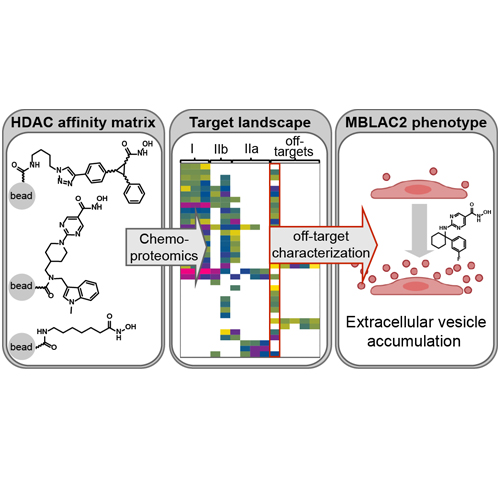Target deconvolution of HDAC pharmacopoeia reveals MBLAC2 as common off-target
2022-04-28
Severin Lechner, Martin Ian P. Malgapo, Christian Grätz, Raphael R. Steimbach, Agnes Baron, Patrick Rüther, Simon Nadal, Carmen Stumpf, Christina Loos, Xin Ku, Polina Prokofeva, Ludwig Lautenbacher, Tino Heimburg, Vivian Würf, Chen Meng, Mathias Wilhelm, Wolfgang Sippl, Karin Kleigrewe, Josch K. Pauling, Karl Kramer, Aubry K. Miller, Michael W. Pfaffl, Maurine E. Linder, Bernhard Kuster, Guillaume Médard
Nat Chem Biol, 2022
Drugs that target histone deacetylase (HDAC) entered the pharmacopoeia in the 2000s. However, some enigmatic phenotypes suggest off-target engagement. Here, we developed a quantitative chemical proteomics assay using immobilized HDAC inhibitors and mass spectrometry that we deployed to establish the target landscape of 53 drugs. The assay covers 9 of the 11 human zinc-dependent HDACs, questions the reported selectivity of some widely-used molecules (notably for HDAC6) and delineates how the composition of HDAC complexes influences drug potency. Unexpectedly, metallo-β-lactamase domain-containing protein 2 (MBLAC2) featured as a frequent off-target of hydroxamate drugs. This poorly characterized palmitoyl-CoA hydrolase is inhibited by 24 HDAC inhibitors at low nanomolar potency. MBLAC2 enzymatic inhibition and knockdown led to the accumulation of extracellular vesicles. Given the importance of extracellular vesicle biology in neurological diseases and cancer, this HDAC-independent drug effect may qualify MBLAC2 as a target for drug discovery.








